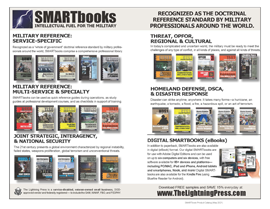Related Books

Disaster Response SMARTbook 3 – Disaster Preparedness (PREVIOUS EDITION)
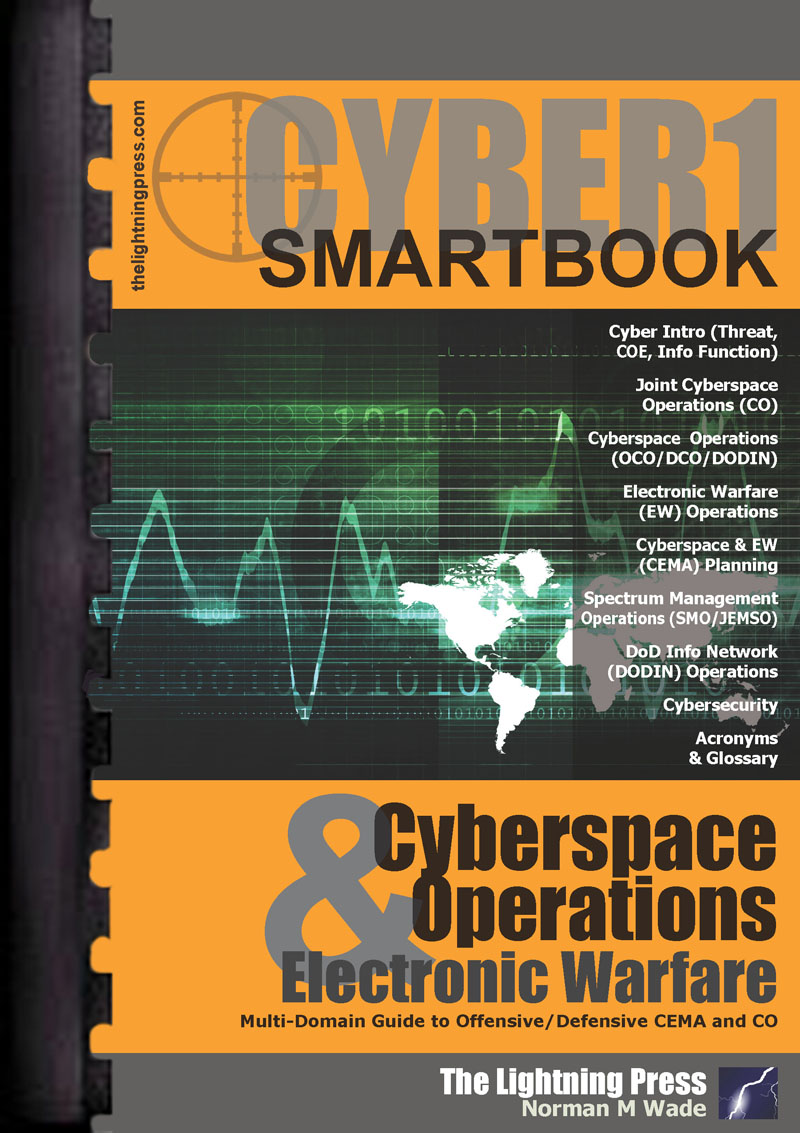
CYBER1-1: The Cyberspace Operations & Electronic Warfare SMARTbook (w/SMARTupdate 1)
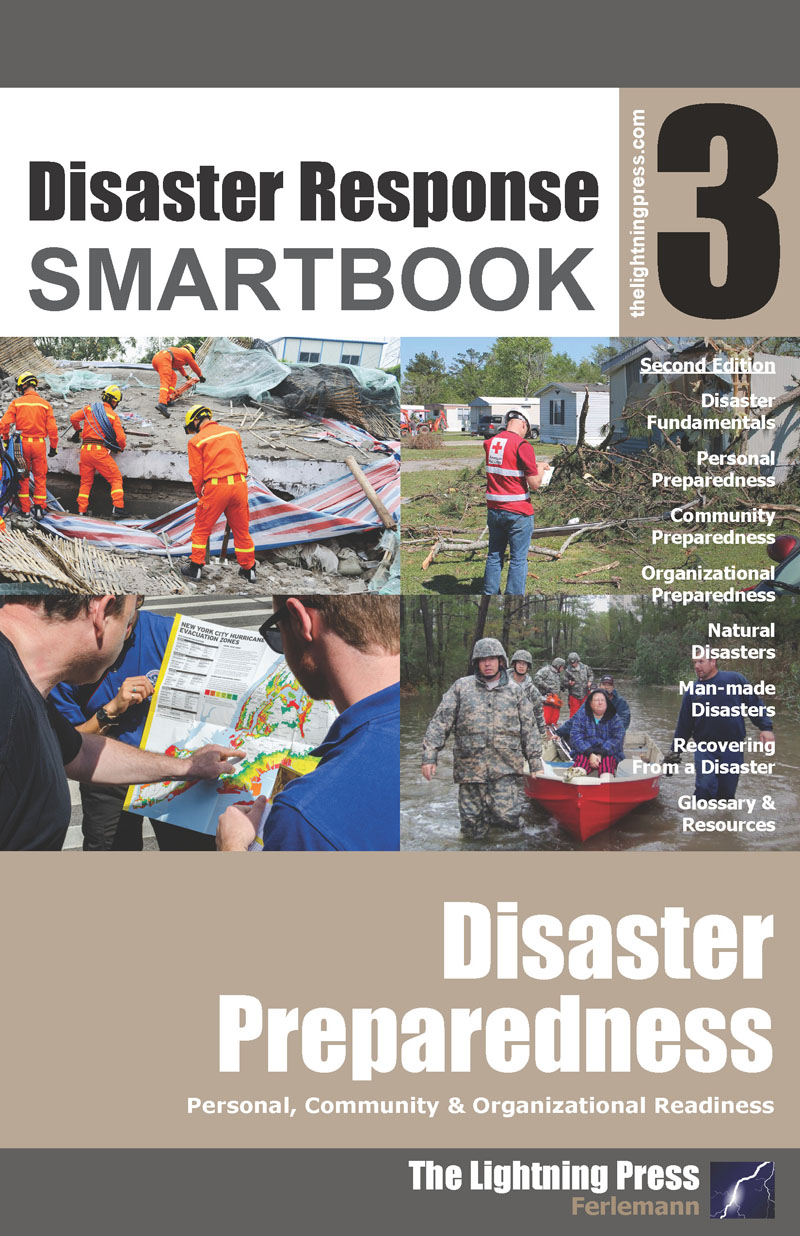
Disaster Response SMARTbook 3 - Disaster Preparedness, 2nd Ed.
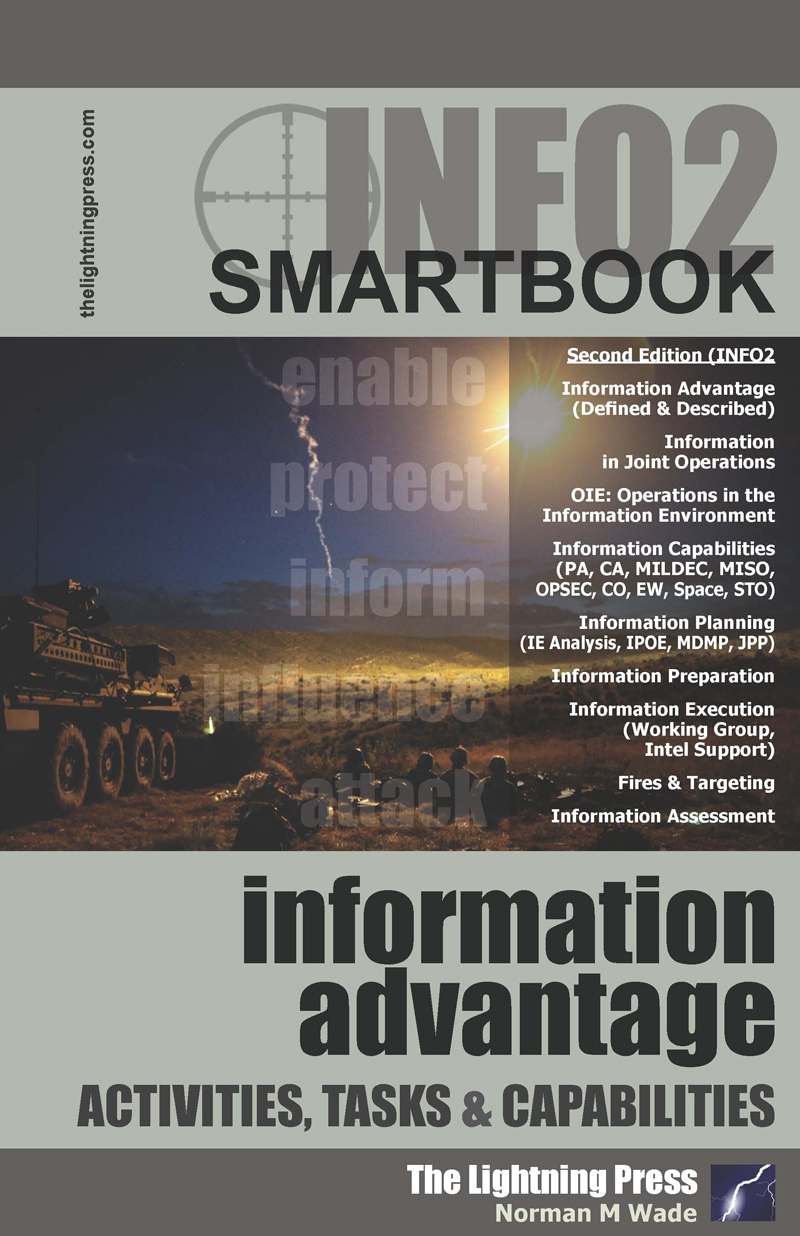
INFO2 SMARTbook: Information Advantage
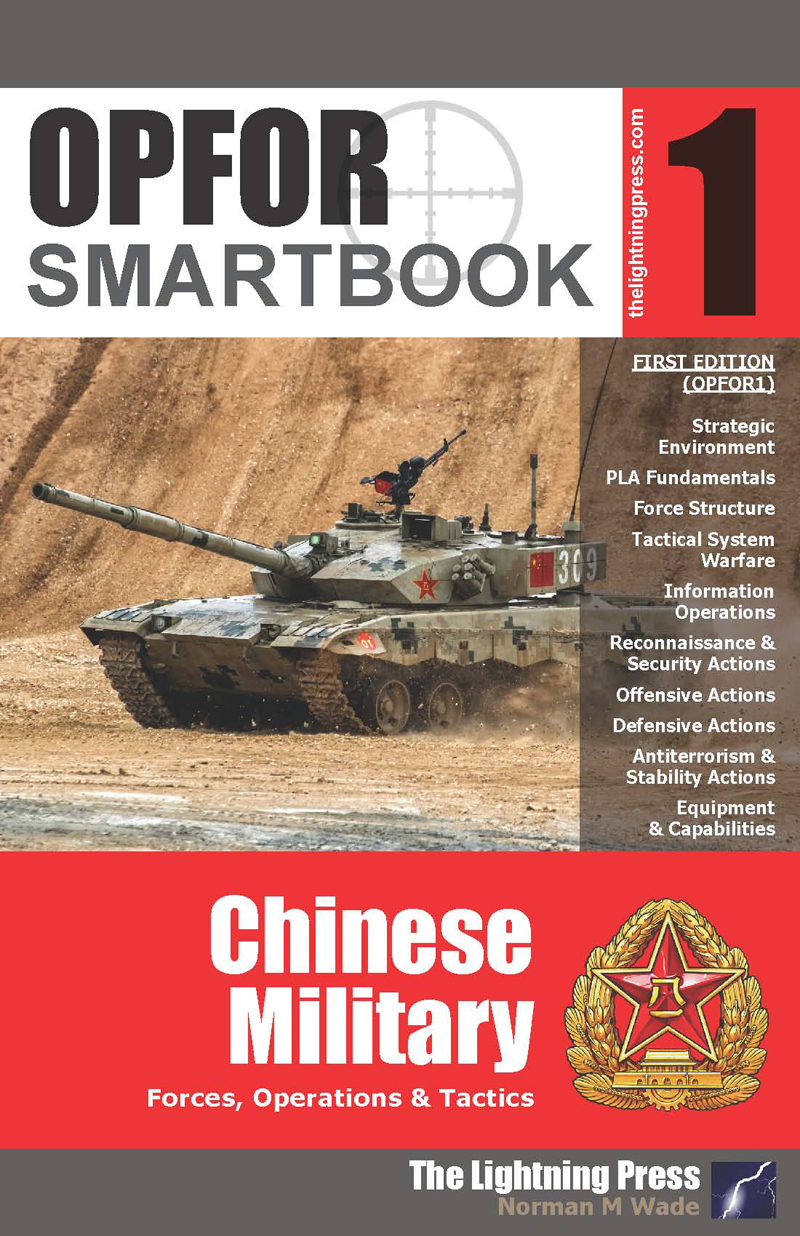
OPFOR SMARTbook 1 - Chinese Military
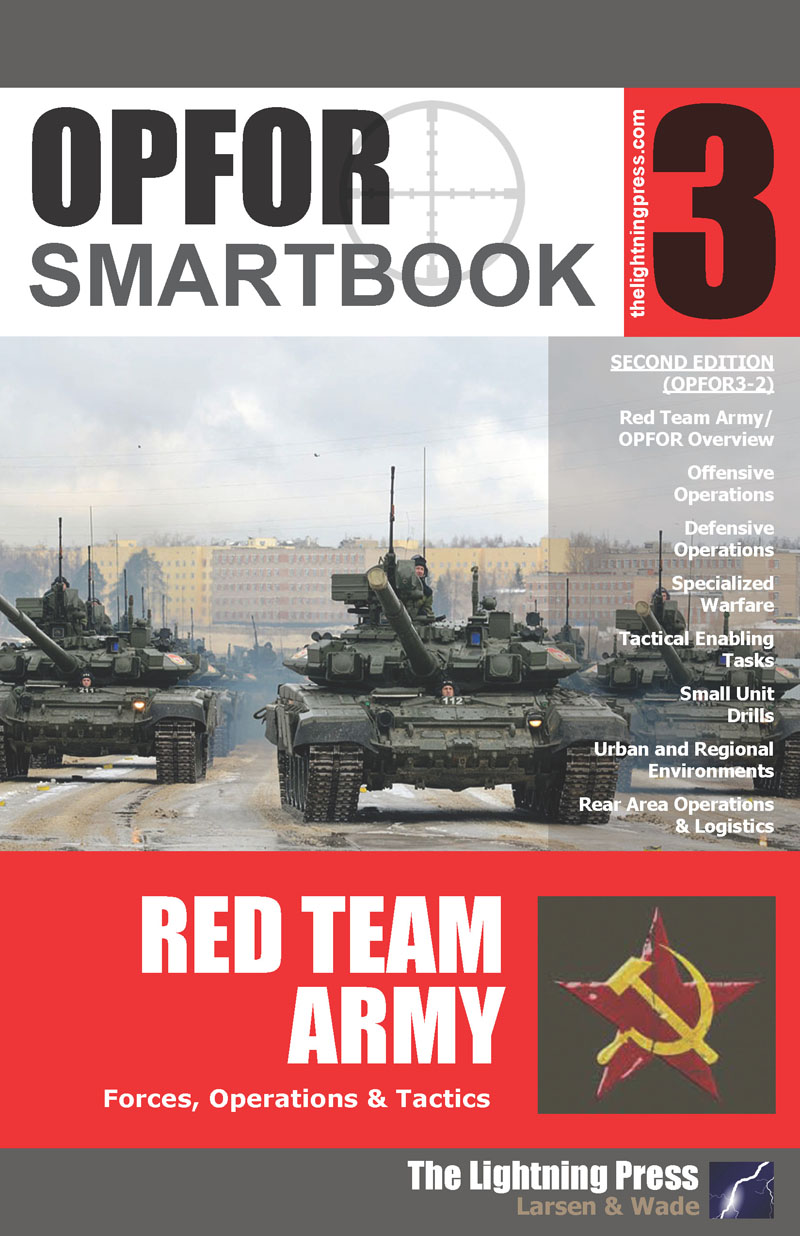
OPFOR SMARTbook 3 - Red Team Army, 2nd Ed.

SUTS3: The Small Unit Tactics SMARTbook, 3rd Ed.
Disaster Response SMARTbook 3 – Disaster Preparedness (PREVIOUS EDITION)

ISBN-10 :1935886487
Release Date :Jan 5th, 2015
Kyle G. Ferlemann
Binding Type:Perfect Bind
Print Inside Pages:Black and White
Trim Size:5.5'' x 8.5''
Total Pages:248

A NEW edition of this book is available!
Disaster Response SMARTbook 3 - Disaster Preparedness, 2nd Ed.
Upgrade/update to the NEW 2nd Edition!
Upgrade/update to the NEW 2nd edition (Jan 2019)!
Click "View Book" above to browse the new edition!
Disaster Response SMARTbook 3 – Disaster Preparedness, 2nd Ed. (Personal, Community & Organizational Readiness) is the updated 376-page second edition of this book. The material has been completely updated and refocused as a planning and preparation guide; topics include disaster fundamentals, personal preparedness, community preparedness, organizational preparedness, natural disasters (hurricanes, earthquakes, wildfires, floods & landslides, volcanoes, tsunamis, tornadoes, drought, famine & extreme heat, blizzards & ice storms, outbreaks, epidemics & pandemics), man-made disasters (hazardous material incidents, nuclear events, explosions & chemical spills, civil disturbances, terrorist incidents, active shooters, cyber threats), and recovering from a disaster.
Always check our website for the most current and up-to-date SMARTbook edition! The Lightning Press is committed to providing the best and most relevant doctrinal material to our readers and are vigilant in reviewing new publications, anticipating upcoming doctrinal releases, and incorporating the updated material into our SMARTbook series!
Related Books
CYBER1-1: The Cyberspace Operations & Electronic Warfare SMARTbook (w/SMARTupdate 1)
ISBN-10 :1935886711
Release Note :Base CYBER1 released Oct '19 (New CYBER1-1 w/SMARTupdate 1 released 22 Sept 21.)
Norman M. Wade
Binding Type:Plastic Comb
Print Inside Pages:Black and White
Trim Size:5.5'' x 8.5''
Total Pages:344

Paperback Edition
Price: $42.95 $36.95

Bundle & Save (Paperback + Digital)
Price: $85.90 $49.95
Multi-Domain Guide to Offensive/Defensive CEMA and CO
CYBER1-1: The Cyberspace Operations & Electronic Warfare SMARTbook (w/SMARTupdate 1*) (Multi-Domain Guide to Offensive/Defensive CEMA and CO) topics and chapters include cyber intro (global threat, contemporary operating environment, information as a joint function), joint cyberspace operations (CO), cyberspace operations (OCO/DCO/DODIN), electromagnetic warfare (EW) operations, cyber & EW (CEMA) planning, spectrum management operations (SMO/JEMSO), DoD information network (DODIN) operations, acronyms/abbreviations, and a cross-referenced glossary of cyber terms.
*SMARTupdate 1 to CYBER1 (Aug ‘21) updates the first printing of CYBER1: The Cyberspace Operations & Electronic Warfare SMARTbook (Oct ‘19) by incorporating new material from FM 3-12, Cyberspace Operations and Electromagnetic Warfare (Aug ‘21), ATP 3-12.3, Electronic Warfare Techniques (Jul ‘19), ATP 6-02.70, Techniques for Spectrum Management Operations (Oct ‘19), JP 3-85, Joint Electromagnetic Spectrum Management Operations (May ‘20) and adding a new section on Cyberspace IPB (ATP 2-01.3, Jul ‘19). (Readers of the original/base CYBER1 can obtain SMARTupdate 1 at www.thelightningpress.com/smartupdates/)
United States armed forces operate in an increasingly network-based world. The proliferation of information technologies is changing the way humans interact with each other and their environment, including interactions during military operations. This broad and rapidly changing operational environment requires that today’s armed forces must operate in cyberspace and leverage an electromagnetic spectrum that is increasingly competitive, congested, and contested.
Cyberspace is a global domain within the information environment consisting of the interdependent network of information technology infrastructures and resident data, including the Internet, telecommunications networks, computer systems, and embedded processors and controllers. Operations in cyberspace contribute to gaining a significant operational advantage for achieving military objectives.
Cyber electromagnetic activities (CEMA) are activities leveraged to seize, retain, and exploit an advantage over adversaries and enemies in both cyberspace and the electromagnetic spectrum, while simultaneously denying and degrading adversary and enemy use of the same and protecting the mission command system (ADRP 3-0). CEMA consist of cyberspace operations, electronic warfare, and spectrum management operations.
Cyberspace operations (CO) are the employment of cyberspace capabilities where the primary purpose is to achieve objectives in or through cyberspace (JP 3-0). Cyberspace operations consist of three functions: offensive cyberspace operations, defensive cyberspace operations, and Department of Defense information network operations.
Electromagnetic Warfare (EW) (formerly "electronic" warfare) is military action involving the use of electromagnetic and directed energy to control the electromagnetic spectrum or to attack the enemy. EW consists of three functions: electromagnetic attack, electromagnetic protection, and electromagnetic support.
Spectrum management operations (SMO) are the interrelated functions of spectrum management, frequency assignment, host-nation coordination, and policy that enable the planning, management, and execution of operations within the electromagnetic operational environment during all phases of military operations. SMO are the management portions of electromagnetic spectrum operations (EMSO). EMSO also include electronic warfare.
Department of Defense information network (DODIN) operations are operations to secure, configure, operate, extend, maintain, and sustain DOD cyberspace.
Cybersecurity ensures the confidentiality, integrity, availability, authentication, and nonrepudiation of friendly information and information systems while denying adversaries access to the same information and information systems. Cybersecurity incorporates actions taken to protect, monitor, analyze, detect, and respond to unauthorized activity on DOD information systems and computer networks.
Related Books
Discount sets with this book
Disaster Response SMARTbook 3 - Disaster Preparedness, 2nd Ed.
ISBN-10 :1935886703
Release Date :Jan 28th, 2019
Kyle G. Ferlemann
Binding Type:Perfect Bind
Print Inside Pages:Black and White
Trim Size:5.5'' x 8.5''
Total Pages:376
UPGRADE / CONVERT this book to premium GBC Plastic-Comb binding!
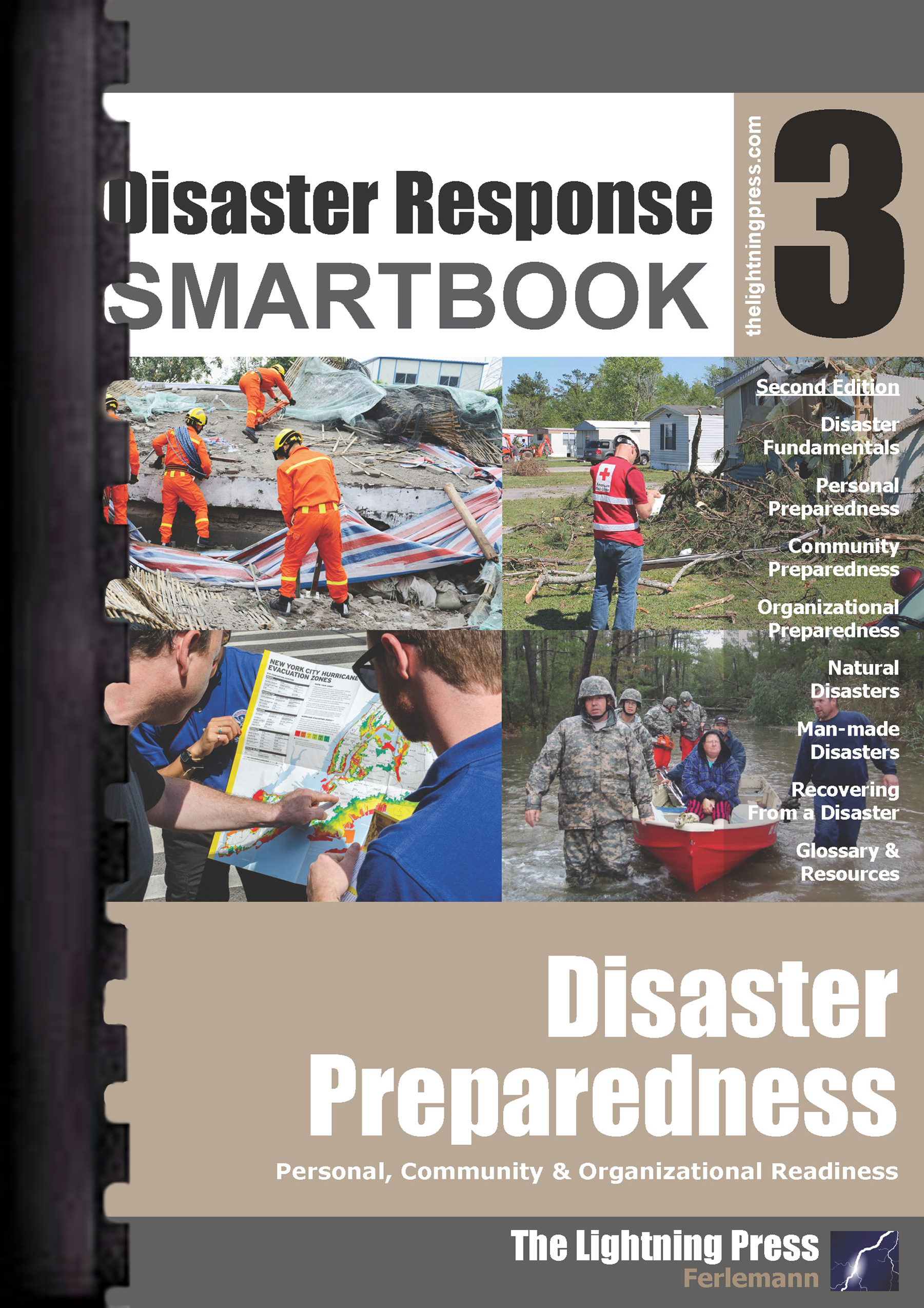

Paperback Edition
Price: $42.95 $36.95

Bundle & Save (Paperback + Digital)
Price: $85.90 $49.95
Personal, Community & Organizational Readiness
Disaster Response SMARTbook 3 – Disaster Preparedness, 2nd Ed. (Personal, Community & Organizational Readiness) is the updated 376-page second edition of this book. The material has been completely updated and refocused as a planning and preparation guide with 128 additional pages of material. Topics include disaster fundamentals, personal preparedness, community preparedness, organizational preparedness, natural disasters (hurricanes, earthquakes, wildfires, floods & landslides, volcanoes, tsunamis, tornadoes, drought, famine & extreme heat, blizzards & ice storms, outbreaks, epidemics & pandemics), man-made disasters (hazardous material incidents, nuclear events, explosions & chemical spills, civil disturbances, terrorist incidents, active shooters, cyber threats), and recovering from a disaster.
Disaster can strike anytime, anywhere. It takes many forms—a hurricane, an earthquake, a tornado, a flood, a fire, a hazardous spill, or an act of terrorism. In the past decade alone, natural disasters of considerable severity resulted in 699 Presidential Disaster Declarations, an average of nearly six per month.
Disaster management (or emergency management) is the term used to designate the efforts of communities or businesses to plan for and coordinate all the personnel and materials required to either mitigate the effects of, or recover from, natural or man-made disasters, or acts of terrorism.
Individuals can make a difference in their own community but not everyone has bought into preparedness. Research on personal preparedness indicates that individuals who believe they are prepared for disasters often are not as prepared as they think. In addition, some admit they do not plan at all.
Our nation’s emergency managers, firefighters, law enforcement officers, EMT/paramedics, and other emergency responders do an incredible job of keeping us safe, but they cannot do it alone. We must all embrace our personal responsibility to be prepared -- in doing so, we contribute to the safety and security of our communities as well.
Planning and preparing can make a big difference in being safe and keeping an organization operational during and after a disaster. The ability to maintain or quickly reestablish operations or organization processes requires a focus on preparedness, advance planning, and relationships with external partners and community leaders.
Recovering from a disaster is usually a gradual process. Safety is a primary issue, as are mental and physical well-being. If assistance is available, knowing how to access it makes the process faster and less stressful.
Related Books
Discount sets with this book
INFO2 SMARTbook: Information Advantage
ISBN-10 :1935886975
Release Date :May 1st, 2024
Norman M. Wade
Norman M. Wade
Binding Type:Perfect Bind
Print Inside Pages:Black and White
Trim Size:5.5'' x 8.5''
Total Pages:344
UPGRADE / CONVERT this book to premium GBC Plastic-Comb binding!
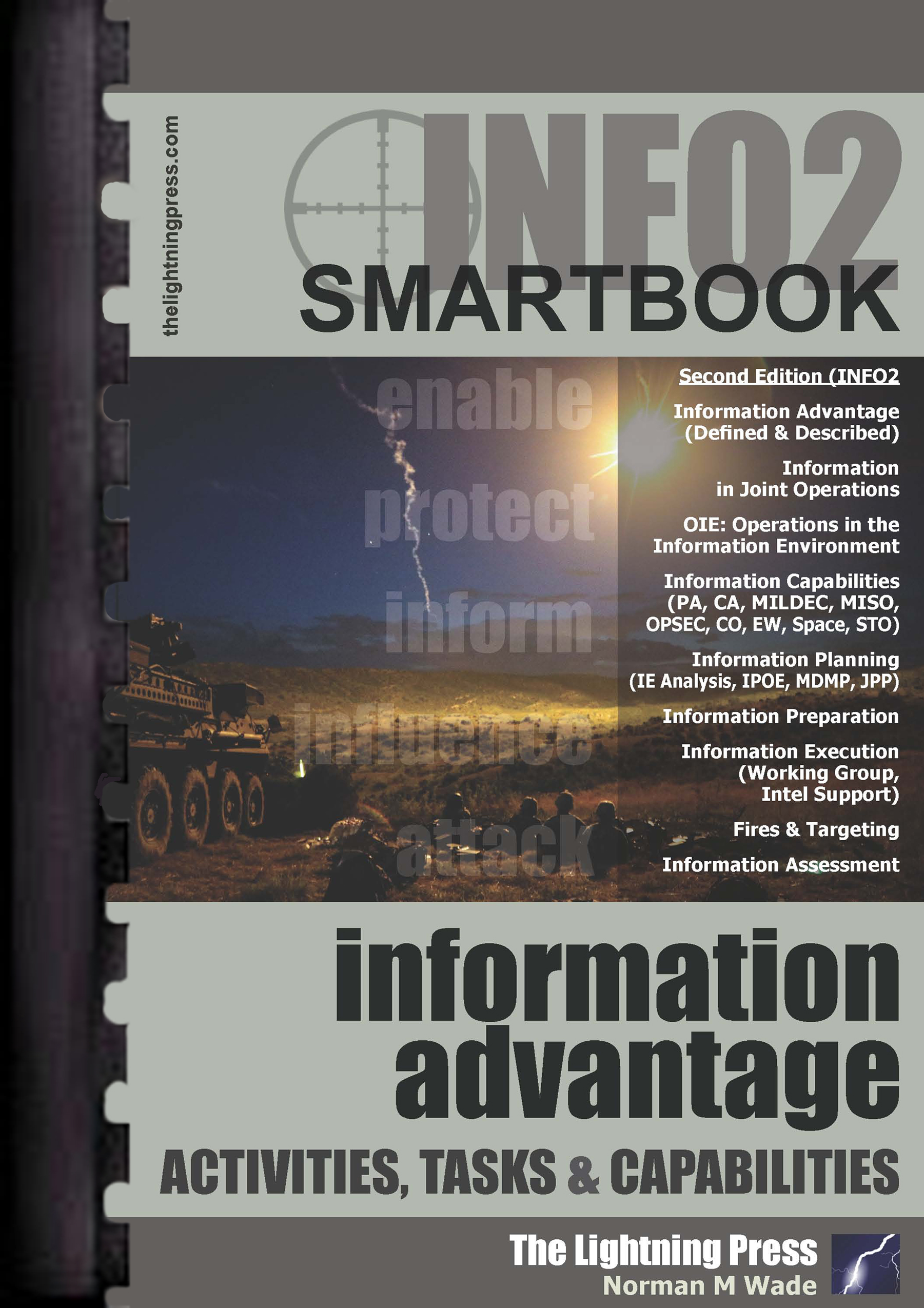

Paperback Edition
Price: $42.95 $36.95

Bundle & Save (Paperback + Digital)
Price: $85.90 $49.95
Activities, Tasks & Capabilities
INFO2 SMARTbook: Information Advantage (Activities, Tasks & Capabilities) is the second edition of our INFO SMARTbook, completely updated for 2024 to include ADP 3-13, Information (Nov '23) and JP 3-04, Information in Joint Operations (Sep '22). At 344 pages, INFO2 chapters and topics include information advantage (enable, protect, inform, influence, attack), information in joint operations (information joint function & OIE: operations in the information environment), information capabilities (PA, CA, MILDEC, MISO, OPSEC, CO, EW, Space, STO), information planning (information environment analysis, IPB, MDMP, JPP), information preparation, information execution, fires & targeting, and information assessment.
Information is central to everything we do—it is the basis of intelligence, a fundamental element of command and control, and the foundation for communicating thoughts, opinions, and ideas. Information is the building block for intelligence and is the basis for situational understanding, decision making, and actions across all warfighting functions. As a critical resource, Army forces fight for, defend, and fight with information while attacking a threat’s (adversary or enemy) ability to do the same.
We no longer regard information as a separate consideration or the sole purview of technical specialists. Instead, we view information as a resource that is integrated into operations with all available capabilities in a combined arms approach to enable command and control; protect data, information, and networks; inform audiences; influence threats and foreign relevant actors; and attack the threat’s ability to exercise command and control.
Army forces create and exploit informational power similarly to the joint force through five information activities (enable, protect, inform, influence, and attack). Army forces also consider information as a dynamic of combat power employed with mobility, firepower, survivability, and leadership to achieve objectives during armed conflict. As a dynamic of combat power, Army forces fight for, defend, and fight with information to create and exploit information advantages—the use, protection, and exploitation of information to achieve objectives more effectively than enemies and adversaries do.
The joint force uses information to perform many simultaneous and integrated activities. The joint force employment of information is of central importance because it may provide an operational advantage.
The elevation of information as a joint function impacts all operations and signals a fundamental appreciation for the military role of information at the strategic, operational, and tactical levels within today’s complex operational environment (OE).
Operations in the information environment (OIE) are military actions involving the integrated employment of multiple information forces to affect drivers of behavior by informing audiences; influencing foreign relevant actors; attacking and exploiting relevant actor information, information networks, and information systems; and by protecting friendly information, information networks, and information systems.
Related Books
Discount sets with this book
OPFOR SMARTbook 1 - Chinese Military
ISBN-10 :1-935886-55-X
Release Date :Aug 9th, 2022
Norman M. Wade
Binding Type:Perfect Bind
Print Inside Pages:Black and White
Trim Size:5.5'' x 8.5''
Total Pages:312
UPGRADE / CONVERT this book to premium GBC Plastic-Comb binding!
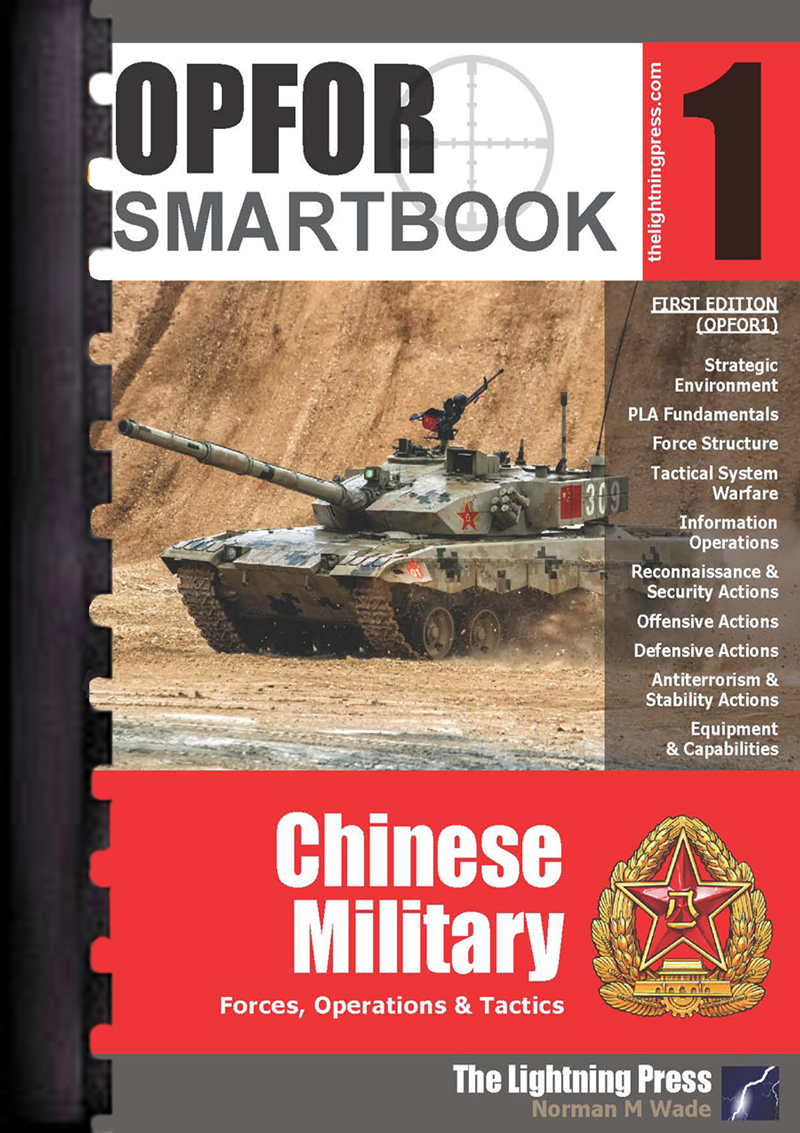

Paperback Edition
Price: $42.95 $36.95

Bundle & Save (Paperback + Digital)
Price: $85.90 $49.95
Chinese Forces, Operations & Tactics
OPFOR1 topics and chapters include the strategic environment (understanding China, defense & military strategy, strategic & operational environments, territorial disputes), force structure (PLA: Army, Navy, Marine, Air Force, Rocket Force, Strategic Support Force), system warfare, information operations, reconnaissance and security, offensive and defensive actions, antiterorrism and stability actions, equipment and capabilities (maneuver, fire support, air defense, aviation, engineer and chemical defense, network and communications, and special operations forces).
For over two thousand years, China has been surrounded by enemies, adversaries, and other competitors. Invasion, occupation, raids, and other incursions into Chinese territory were commonplace. The People’s Liberation Army (PLA) views protecting Chinese sovereignty and security as a sacred duty. China traditionally viewed military resistance as an affair for the entire population: mass resistance, guerrilla warfare, and winning a war of attrition.
The People’s Liberation Army Army (PLAA) has approximately 975,000 active-duty personnel in combat units. The PLAN is the largest navy in the world with a battle force of approximately 355 platforms, including major surface combatants, submarines, aircraft carriers, ocean-going amphibious ships, mine warfare ships, and fleet auxiliaries. The Air Force (PLAAF) and PLAN Aviation together constitute the largest aviation forces in the region and the third largest in the world, with over 2,800 total aircraft (not including trainer variants or UAVs) of which approximately 2,250 are combat aircraft (including fighters, strategic bombers, tactical bombers, multi-mission tactical, and attack aircraft). The PLA Rocket Force (PLARF) is the largest missile force in the world, operating well over 1,000 short-range, medium-range, and intercontinental ballistic missiles (ICBMs) and over 300 long-range cruise missiles.
With a force that totals approximately two million personnel in the regular forces, the PLA has sought to modernize its capabilities and improve its proficiencies across all warfare domains so that as a joint force it can conduct the range of land, air, and maritime operations as well as space, counterspace, electronic warfare (EW), and cyber operations. Recognizing that joint operations, information flows, and rapid decision-making are vital in modern warfare, the PRC continues to place a high priority on modernizing the PLA’s capability to command complex joint operations in near and distant battlefields.
The PRC has stated its defense policy aims to safeguard its national sovereignty, security, and development interests. China’s leaders view these interests as foundational to their national strategy. In 2020, the PRC’s defense policy and military strategy primarily oriented the PLA towards “safeguarding” its perceived “sovereignty and security” interests in the region counter the United States. At the same time, China’s leaders increasingly cast the armed forces as a practical instrument to defend Beijing’s expanding global interests and to advance its foreign policy goals within the framework of “Major Power Diplomacy with Chinese Characteristics.”
Related Books
Discount sets with this book
OPFOR SMARTbook 3 - Red Team Army, 2nd Ed.
ISBN-10 :1-935886-78-9
Release Date :Oct 15th, 2019
Cover Type:Gloss U.V. Coating
Binding Type:Perfect Bind
Print Inside Pages:Black and White
Trim Size:5.5'' x 8.5''
Total Pages:264
UPGRADE / CONVERT this book to premium GBC Plastic-Comb binding!


Paperback Edition
Price: $42.95 $36.95

Bundle & Save (Paperback + Digital)
Price: $85.90 $49.95
Red Team Army: Forces, Operations & Tactics (OPFOR3-2)
It has been nearly thirty years since a holistic explanation of the Soviet-based Opposing Force (OPFOR) was examined in the U.S. Army Field Manual 100-2 series. Recognizing this, OPFOR SMARTbook 3: Red Team Army re-examines and outlines the doctrinal operational construct and historical foundations of Soviet-era military forces from the FM 100-2 series, which is now out-of-print and largely unavailable. Second, OPFOR SMARTbook 3 reorganizes that foundational material and aligns it in keeping with contemporary military doctrinal taxonomy. Third, OPFOR SMARTbook 3 translates and bridges the strategic- and operational-level doctrine into tactical application at the small-unit level. Through this triangulation, a more modern rendition of Red Team Armies emerges.
OPFOR3-2 is the second edition of OPFOR SMARTbook 3 - Red Team Army, completely revised for 2019. In addition to the base FM 100-2-1/2/3 Soviet Threat series, new/updated material includes the FM/TC 7-100 Opposing Forces series, FM 3-0 Operations (Oct ‘17), ADP 3-90 Offense and Defense (Aug ‘18), FMs 3-90-1 & -2 (May ‘13), a review of modern (present-day) Russian forces, and more than a dozen historical vignettes. At 264 pgs, this second edition also features an additional 32 pages over the original first edition.
OPFOR3 topics and chapters include an Opposing Force Overview/Introduction, Red Team Army Overview (Military Doctrine, Operational Concept, Personnel & Training, Force Structure, Motorized Rifle Regiment, Modern Russian Land Forces), Offensive Operations (Front & Army Operations, Division and Lower Tactics, Small Unit Tactics), Defensive Operations (Prepared Defense, Hasty Defense, Withdrawal & Relief, Small Unit Tactics), Specialized Warfare (Airborne, Heliborne, Amphibious, Unconventional Warfare), Tactical Enabling Tasks (Reconnaissance, River Crossings, Troop Movement, Relief in Place, Passage of Lines, Checkpoints), Small Unit Drills (Movement & Formations, Dismounted and Mounted Patrols), Urban & Regional Environments (Urban, Mountain, Desert, Cold Wx, and Nighttime Operations), and Rear Area Operations & Logistics.
Editor's Note: Future editions will be updated to focus centrally on modern Russian forces, operations, tactics and lessons learned in the Ukraine.
Related Books
Discount sets with this book
SUTS3: The Small Unit Tactics SMARTbook, 3rd Ed.
ISBN-10 :1-935886-77-0
Release Date :Mar 1st, 2020
Cover Type:Gloss U.V. Coating
Binding Type:Plastic Comb
Print Inside Pages:Black and White
Trim Size:5.5'' x 8.5''
Total Pages:344

Paperback Edition
Price: $42.95 $36.95

Bundle & Save (Paperback + Digital)
Price: $85.90 $49.95
Planning & Conducting Tactical Operations
SUTS3: The Small Unit Tactics SMARTbook, 3rd Ed. is the third revised edition of The Small Unit Tactics SMARTbook, completely updated for 2019 to include ADP 3-90 Offense and Defense (Jul ‘19), FM 3-0 Operations w/Change 1 (Dec ‘17), FMs 3-90-1 & -2 (May ‘13), ATP 3-21.8 Infantry Platoon and Squad (Apr ‘16), ATP 3-21.10 Infantry Rifle Company (May ‘18), TC 3-21-76 The Ranger Handbook (Apr ‘17), and the latest versions of more than 20 additional references. SUTS3 also features a return of our premium GBC plastic-comb binding for a true open-flat reference experience!
At 344-pages, chapters and topics include tactical mission fundamentals, the offense, the defense, stability and counterinsurgency operations, tactical enabling tasks (security, reconnaissance, relief in place, passage of lines, encirclement, and troop movement), special purpose attacks (ambush and raid), urban and regional environments (urban, fortified areas, desert, cold region, mountain, and jungle operations), patrols and patrolling.
Tactics is the employment and ordered arrangement of forces in relation to each other. Through tactics, commanders use combat power to accomplish missions. The tactical-level commander uses combat power in battles, engagements, and small-unit actions.
The nature of close combat in land operations is unique. Combatants routinely come face-to-face with one another in large numbers in a wide variety of operational environments comprising all types of terrain. When other means fail to drive enemy forces from their positions, forces close with and destroy or capture them.
Offensive actions are combat operations conducted to defeat and destroy enemy forces and seize terrain, resources, and population centers. They impose the commander’s will on the enemy. A commander may also conduct offensive actions to deprive the enemy of resources, seize decisive terrain, deceive or divert the enemy, develop intelligence, or hold an enemy in position. The four primary offensive tasks are movement to contact, attack, exploitation, and pursuit.
A defensive task is a task conducted to defeat an enemy attack, gain time, economize forces, and develop conditions favorable for offensive or stability tasks. Although on the defense, the commander remains alert for opportunities to attack the enemy. A defending force does not wait passively to be attacked, aggressively seeking ways of attriting and weakening enemy forces before close combat begins. There are three basic defensive tasks—area defense, mobile defense, and retrograde.
The Small Unit Tactics SMARTbook translates and bridges operational-level doctrine into tactical application -- in the form of tactics, techniques and procedures -- and provides the “how to” at the small-unit level as a ready reference at the battalion, company, platoon, squad and fire team level.
Related Books
Discount sets with this book













